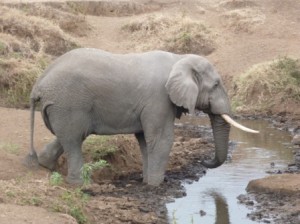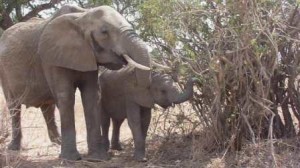
Using her trunk as a hand and arm, an elephant feeds herself.
What would you do with a trunk if you had one? Would you use it to pick up things? To suck up water? Would Dylan be able to make an even louder trumpeting noise?!

Using her trunk as a hand and arm, an elephant feeds herself.
A long trunk is a wonderful adaptation that has developed in elephants over many generations, during the millions of years they've been on earth. Millions of years ago they didn't have the very long trunk that they do now. However, those that had a longer trunk than their peers were able to survive longer and have more babies who also had longer trunks. This process repeated itself generation after generation as the elephant evolved into the animal with the long "nose" we recognize today.

An elephant vacuums up water with her trunk and then squirts it into her mouth.
So, how does a trunk help an elephant? It uses it as a suction device to suck up water, and then squirt it into its mouth. It can't drink the water through its trunk, because the trunk is also its nose. I loved watching them do this when we came upon some elephants at a river. Since it's a nose, the elephant can also inhale dirt into its trunk and then blow it out over its head to get rid of bothersome bugs. You'll see an elephant do this in the video.

An elephant vacuums up water with her trunk and then squirts it into her mouth.

A calf picks up a strip of bark, just as he's seen his mother do. What do you think he does next?
The elephant also uses the trunk as a hand. It picks up branches to eat, and sometimes even throws them at an enemy! It touches another elephant with its trunk as a sign of friendship.

A calf picks up a strip of bark, just as he's seen his mother do. What do you think he does next?
Here are two very surprising ways I saw the elephant use its long nose. It touches the ground in front of it when walking to make sure it's safe. You'll see this in the video of the mommy elephant and calf (baby elephant) crossing the road. Notice that they keep touching the ground with their trunks. The calf won't go down to the road until he's sure his trunk can touch the ground first.
Secondly, if an elephant hasn't seen a friend in awhile, it will put its trunk into the other's mouth as a friendly gesture. Warning. Don't do this the next time you see your friend. Just give a high five!
The trunk is also used as a signalling device. The elephant raises its trunk and makes a loud trumpeting sound when it wants to call other elephants or scare a predator away. Now, wouldn't it be fun to be able to do THAT?!

A calf learns to get food by watching her mother.
Of all the animals we saw on safari, the elephants were the most interesting to watch. They are very intelligent animals that socialize a lot with each other. (Many other kinds of animals hang out together in herds, but don't really socialize with each other.) The best entertainment on the Serengeti is watching baby elephants. They push and tease each other, play together, playfully fight, and also try to imitate the grown-up elephants.

A calf learns to get food by watching her mother.
I saw one calf that went off with his friend. He realized he had wandered too far away from his mommy and couldn't find her. He began looking this way and that, running around the many elephants that were standing in the herd. It was easy to see he was worried. Finally he found her! They touched each other tenderly with their trunks, and then he stayed very close to her.

The liquid that comes out of a hole on an elephant's head has a particular smell to help the elephants identify each other.
How does a calf recognize its mother? Smell. If you look closely at some of the photos on this page, you see a dark wet stain on the elephant's face, between the eye and the ear. The liquid has a smell that's unique to that animal. People have unique smells too, although usually we try to decrease them by bathing often and using deodorant. Still, I bet if you blindfolded yourself you could recognize your parent by smell alone. Give it a try!

The liquid that comes out of a hole on an elephant's head has a particular smell to help the elephants identify each other.

Calves are taken care of by their mother and aunts.
We saw many elephant herds while on safari. They were made up of 10 – 20 female (women) elephants and several calves. The mother and the "aunts" all help raise the calves together. Herds are always led by the oldest, largest female. She will lead the way when going to a new place where there might be danger, and she'll make sure she's last when the herd is running away from danger, always protecting her herd. A group of females typically stay together all their lives – over 50 years!

Calves are taken care of by their mother and aunts.
When we saw an elephant by itself, we knew it was a male (man). The adult males usually live alone, although they may travel with a few other males for a little while, before going their own way again. Similarly, males will come visit the female herds for awhile, but then go off on their own again.
Sometimes male elehants will fight. If you ever see an elephant lifting its head very high, with its ears forward, and quickly unfurling its trunk as it makes a loud trumpeting sound, you've got a big problem. Those are the signals that the elephant is about to charge at you! If you were another big elephant, he would tuck his trunk under (as it's actually quite sensitive) and get ready to hit you with his head and tear you with his two long teeth (tusks).

How does an elephant scratch its back?
Here's the good news and bad news about elephants in an ecosystem . The bad news is that they're really hard on their habitat. They're herbivores, so they eat only plants (no meat). But they have really big bodies, so they need A LOT of food. I'm sure you can guess the result. A herd of elephants will eat not only the leaves off the trees, but it will then eat the branches, and THEN it will strip the bark off the trees with its tusks for dessert! If an elephant can't reach the high branches it wants, it'll keep hitting its head on the trunk of the tree until it knocks it over. Needless to say, this kills many trees, and can destroy an entire forest.

How does an elephant scratch its back?


Elephants are so intelligent! I didn’t realize they also have feelings and personality.
that so cool i wish i was in your class again
I LOVE THE BABY ELEPHANTS!! THEIR SO CUTE!!
🙂 :~)
hi miss christieblick elephants are so interesti ng
Are you used to seeeind wild animals like elephants every day?
I saw elephants almost every day when I was in the countryside in the country of Tanzania. Now that I’m in the suburbs of South Africa, I only see the smaller mammals, like baboons, mongooses, and guinea fowl. There are elephants in some parts of South Africa, but they need lots of wild countryside to roam around.
It must of been scarey
I like elephants and I didn't know they could be so cool. Elephants are lovely animals. I love all the inphomashon.
Elephants sound realy cool. i wonder what im going to see later onin the year.in addo elephant park. bye bye.
Did the Elephants chage at you.
One elephant did a pretend charge at our safari truck to try to scare us off. It worked! We moved away.
do you no that elephants are clever
I have saw that elephants use there trunks alot. is that because they dontt have good seeing
Good observation, Samantha! You’re right. Elephants have rather poor eyesight. They compensate by using their trunk to feel, and using their keen sense of smell and hearing (which is much better than humans’). When they looked toward our safari truck, they could see the truck, but they couldn’t distinguish all the images inside the truck. They didn’t know there were people inside!
hi do calfs have littlel hairs on there head
Your question about hair is an interesting one, Samantha. All mammals have hair on them. It protects the animal. But different animals have hair in different places. Yes, an elephant calf has hair on its head, and on its back. Hair on the body helps keep it warm. As it grows older, and develops more body fat to keep it warm, the hair drops out and is not replaced. Elephants over one year of age do not have hair over their head and back. An elephant has quite long hairs on the end of its tail. I’ll bet you can guess what it uses it for!
The elephant also has hair around its eyes and at the tip of its nose, just like people, and many other animals. The little hairs help keep germs, and other stuff floating in the air, out of the eyes and nose. That helps the animal survive. The little hairs on the end of its trunk also help the animal feel things. When I watched the elephants I often saw them using the tip of their trunk to feel each other, the road, a tree branch. It helps the elephant to understand it, just as a kid touches everything (especially something it’s never seen before) as it tries to understand it.
Samantha, while researching the answer to your question, I came across a really good website, http://elephant.elehost.com/index.html . It has all kinds of FASCINATING information and pictures of elephants. Go visit. You’ll love it!
That was awesome!! You are very lucky. Could you please answer these questions. Why do elephants have big ears and tusks?
Elephants have big ears and tusks because those body parts have helped them survive. The large ears help them regulate their body temperature. They are also used to shoo away bugs. The elephant also moves the ears out and forward to make itself look bigger when it’s about to attack its enemy. The tusks are used to attack an enemy, and also to strip bark and branches off trees. Sadly, I read in the newspaper this week that a man got killed by an elephant while he was on safari in the country of Botswana. The man was not in a truck; he was walking around. I don’t know what he did to upset the elephant, but the elephant gored him with its tusks. People sometimes forget that these are wild animals.
Those baby elephants are so cute ! How many babies does an average elephant have? Hope you are having a fun time in South Africa.
Hi Alexandra! Interesting question. I had to look that one up. A female elephant gives birth to only one baby at a time, but she gives birth to a total of about 10 babies during her entire life.
The baby elephant looks like Dumbo the elephant with the big ears.
Elephants are cool!
Now the elephants are awesome. I wish I could go.